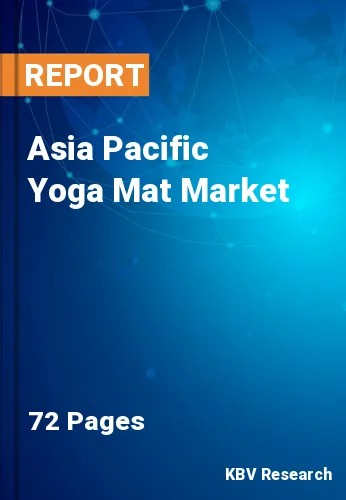The Asia Pacific Yoga Mat Market would witness market growth of 6.2% CAGR during the forecast period (2022-2028).
Asana practice had advanced to the point where many Yogis were employing rugs at this point. These carpets were constructed from cotton or synthetic equivalents, and they had the same shape as the rectangular mats are accustomed to today. The more dynamic posture-based practice (as well as the other limbs of yoga, of course) was gaining popularity and was spreading all over the world. A smart Yogini created the first yoga mat during this decade out of a piece of foam carpet underlay! As a result, the mat as know it today was established.
Asana practice is performed on specially crafted mats called "yoga mats" to prevent hands and feet from slipping. A sticky mat was an early version involving rubber carpet underlay that was invented by yoga instructor Angela Farmer in 1982. Traditionally, Hatha and meditation yoga were practiced on bare ground, often with rugs made from deer or tiger leather. Modern yoga mats are constructed of plastic, rubber, and occasionally other materials like hessian and cork, balancing price, comfort, grip, and weight.
Although most gyms and fitness centers in China provide yoga courses and services, few customers pay for these lessons. Free yoga lessons are provided by several large and medium-sized fitness centers to increase foot traffic and membership sales, which are subsequently upsold with personal training sessions. The overall amount spent on offline yoga classes in 2018 was larger (68.9%) than the total amount spent on online courses (31.1 percent). However, Chinese yogis have started to prefer taking online lessons as a result of the COVID-19 pandemic, which further drove China's fitness business online. In addition, because of the nature of yoga, many clients prefer to practice yoga at home with the help of fitness APPs like KEEP.
The China market dominated the Asia Pacific Yoga Mat Market by Country in 2021, and would continue to be a dominant market till 2028; thereby, achieving a market value of $1,351.5 million by 2028. The Japan market is estimated to grow a CAGR of 5.5% during (2022 - 2028). Additionally, The India market would experience a CAGR of 6.8% during (2022 - 2028).
Based on Material, the market is segmented into PVC, Rubber, Thermoplastic Elastomer, Polyurethane, and Cotton/Jute. Based on Distribution Channel, the market is segmented into Specialty Store, Departmental Store & Hypermarket, and Online Channel. Based on End User, the market is segmented into Yoga & Fitness Clubs, Household, and Others. Based on countries, the market is segmented into China, Japan, India, South Korea, Singapore, Malaysia, and Rest of Asia Pacific.
Free Valuable Insights: The Worldwide Yoga Mat Market is Projected to reach USD 13.4 Billion by 2028, at a CAGR of 5.8%
The market research report covers the analysis of key stake holders of the market. Key companies profiled in the report include Adidas AG, Lululemon Athletica, Inc., Hugger Mugger Company, Inc., Manduka, LLC, Prana (Columbia Sportswear Company), Aurorae, LLC, Ecoyoga Ltd., EuProMed s.r.o., Jade Yoga, and Yaazhtex.
By Material
By Distribution Channel
By End User
By Country
Our team of dedicated experts can provide you with attractive expansion opportunities for your business.

